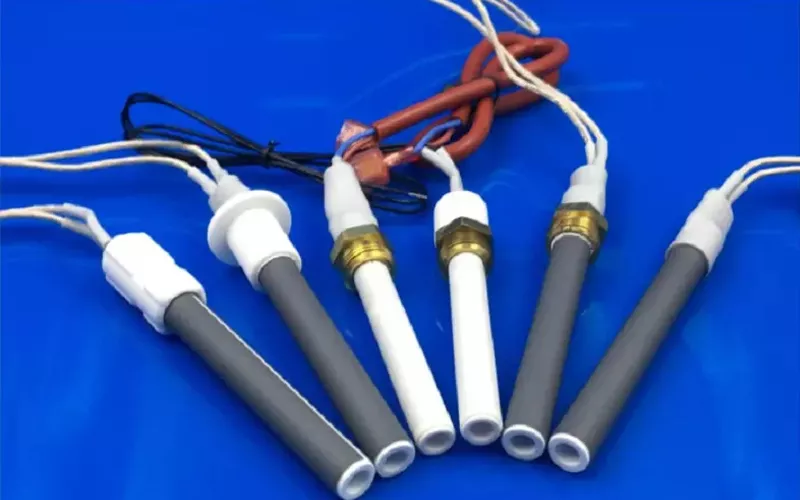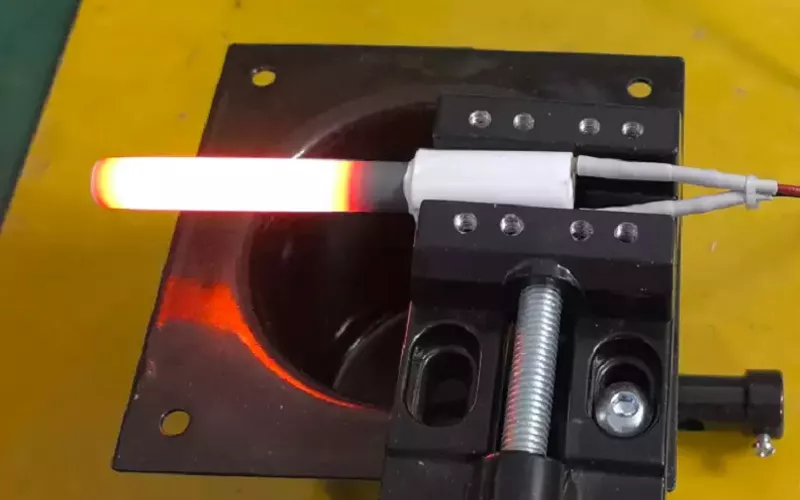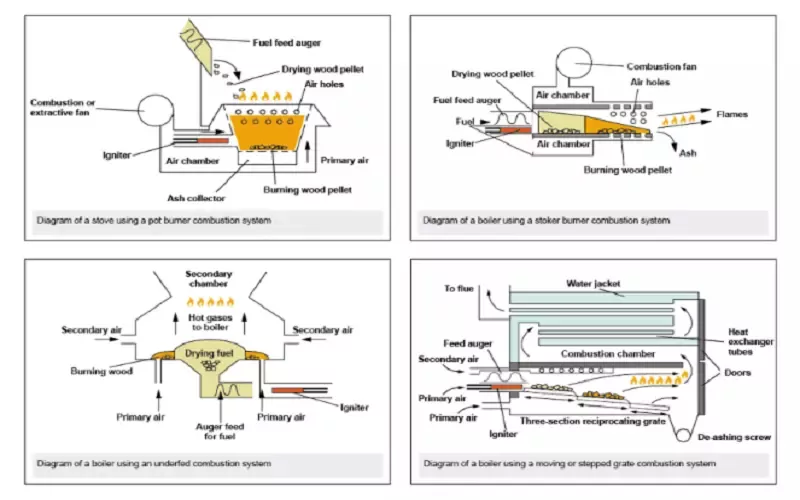Perkenalan
The installation process of ceramic particle igniters in pellet burners has made them a more efficient heating option. However straightforward these ceramic particle igniters may seem, it’s still important to learn how to install them, as proper installation ensures better usage. Alright, let’s get started!

Diagram 1: Ceramic Particle Igniters
Characteristics Of Ceramic Particle Igniters
Ceramic particle igniters are a special kind of heating device made to ignite pellets, biomass/particles in pellet stoves and burners. As their name implies, they’re made from advanced ceramic materials, such as silikon karbida, alumina, and silicon nitride. Their primary job is to ensure heating systems like pellet burners work effectively. They do this by igniting the pellets in a burner and starting fires very quickly.
You can use these ceramic igniters in production industries, engineering firms, and even at home due to their amazing properties. Examples are industrial kilns, household items like water boilers, bathroom heaters, pellet stove igniter, pellet burner igniter, barbecue grills, ovens, sterilizers, etc.
The truth is, before now, most people relied on traditional metal rods, a flame, or a spark to heat up pellet stoves. Today, ceramic igniters have taken center stage because they withstand extreme temperatures (up to 1,000 °C) and heat up very fast. They are also very durable and energy-saving. This means they will save you time and energy, compared to other types.
Ceramic igniters come in various shapes and sizes, depending on the requirement, or the make and model of your pellet stove. However, don’t forget they all do the same job, which is - Conversion of electrical energy to heat.
Now, let’s see some of the amazing properties of ceramic particle igniters:
-
They have a maximum operating temperature of 1’200°C.
-
They heat up very quickly (reaching ignition temperature in 30 - 60 seconds).
-
Thermal conductivity of about 25–30 W/m·K at high temperatures.
-
They have a dielectric strength of 10–15 kV/mm.
-
They have a flexural strength of 250–350 MPa.
-
They have a low coefficient of thermal expansion, about 6–8 × 10⁻⁶ /K.
-
They’re very durable and can last more than 10,000 ignition cycles (about 5-10 years), depending on the maintenance and usage conditions.
-
They’re reliable even in harsh working conditions.
-
They’re more energy-saving compared to metal/quartz igniters.
-
Bagus sekali isolator listrik.
How To Install a Ceramic Particle Igniter
Ceramic particle igniters are very simple to install. Let’s go through the steps you must follow:

Diagram 2: Installing Particle Igniter
-
Your safety comes first, so ensure to turn off the electric power source and unplug the stove.
-
Open the panel where the pellets ignite - If you’re replacing an old igniter, then remove it completely from the igniter slot. It’s usually at the bottom or side of the pellet stove.
-
Ensure the slot is empty and ready for a new ceramic igniter.
-
Insert the new ceramic igniter by carefully sliding it into the slot.
-
Check to confirm that it aligns properly with the slot. This will make the pellet stove get heat directly.
-
Connect the ceramic igniter wires to the screw terminal.
-
Cross-check all connections that you’ve made to ensure they are tight and well-insulated.
-
Now, use a screw or a clip to hold the igniter firmly in the slot so that it doesn’t shift while working.
-
Reassemble the stove; put back any panels, covers, or parts you removed.
-
You can plug in the electricity source and turn on the pellet stove igniter.
-
Run a test to see if you’ve properly installed the igniter.
Tip: If you’ve done a good installation, then the ceramic igniter should glow orange/red within 30 - 60 seconds and ignite the pellets.
How Does a Ceramic Particle Igniter Work?
A ceramic igniter works by simply converting electrical energy to heat and starting a fire from it. How - When you pass electricity through the ceramic igniter, it heats up almost immediately (getting as high as 1,100 °C in a few seconds). This heat makes the ceramic surface red hot, if it was well installed, then the already hot surface would immediately ignite the wood pellets or particles inside the burner.

Diagram 3: How Particle Igniter Works
All these processes can comfortably take place within a few minutes because of the advanced bahan keramik used in producing these igniters. Not only do they handle very high temperatures, but they also retain heat excellently well without cracking. The ignition process is very reliable, stable, and uses a lesser amount of energy compared to metal igniters.
Since wood pellet stoves operate with electricity and produce creosote buildup, they’re more efficient than a wood stove. After you’ve loaded the pellets into the hopper, the pellet stove igniter can automatically start the fire once the control board sends an electric signal. Without much assistance, the pellet stove igniter can help you create heat in your home by burning these biomass pellets.

Diagram 4: Pellet Stove
They can be quite expensive to purchase, but their strength and durability make up for the cost. So, you don’t have to worry about replacing them regularly, unlike metal/quartz igniters.
Global Market Size and Market Value of Ceramic Particle Igniters
The global market for ceramic igniters was valued at about $1.2 billion in 2024, according to verified market reports. Currently, the Compound Annual Growth Rate is 9.2% and with this, the market has been estimated to approach $2.5 Billion by 2033. That’s a massive growth rate, clearly showing how well ceramic particle igniters are in high demand globally.
So, if you’re an investor, now may be the best time to consider this line. Also, if you’re among those looking to purchase these pellet stoves and burners, here are some top market suppliers:
-
Hearth and Home Technologies
-
Ravelli
-
Rika
-
Edilkamin
-
Napoleon
Safety Precautions to Take While Installing a Ceramic Particle Igniter
If you’re aiming for a successful installation process, then you must abide by the required safety precautions. Some of them are:
-
To prevent electrical shock, always disconnect the pellet stove from the electrical supply.
-
You can reduce the risk of burnout by using a ceramic particle igniter with a similar voltage to your pellet stove.
-
Ensure that there’s an interspace of at least 3mm around the tube and the ceramic heating element.
-
Use long and firm protective tubes - This will prevent the igniter from contaminating materials like dust, solid fuels, ashes, etc.
-
Always use heat-resistant and well-insulated wires to avoid short circuits.
-
Ensure you fit the ceramic igniter properly in its place so it doesn’t touch other parts of the pellet stove.
-
While you’re installing the ceramic igniter, ensure you don’t overtighten the screws/clip.
-
Ensure you use the right igniter size; using the wrong size may not properly fit in and subsequently cause problems.
-
Also, make sure to use a ceramic pellet igniter model that matches the pellet stove/burner.
-
To avoid getting burned, don’t touch the surface of the ceramic igniter with your bare hands while testing.
To extend the lifespan of your pellet stove and ceramic igniter:
-
Ensure you handle the burner with care. Don’t hit it against a hard surface.
-
Regularly clean off dust, oil/water, and other debris from the surface.
Contact us now at Keramik GGS for durable and high-temperature-resistant ceramic particle igniters. Our products are there to serve your heating needs. Don’t wait!
Pertanyaan yang Sering Diajukan
Do all pellet stoves require electricity?
The majority of them (Pellet stoves) need an electrical supply to work. Why - because fire can only be produced and hot air blown out through their motorized components (which use electricity).
Does a pellet stove create flames?
Yes, they burn clearly and have controlled flames that do not spark or create the risk of airborne embers.
Can I replace a metal or quartz igniter with a ceramic particle igniter?
It depends on the type of pellet stove and burner you’re using. Although most pellet burners tend to accept ceramic particle igniters as direct replacements for older quartz or metal igniters, as long as the connector type, size, and voltage match.
Kesimpulan
Ceramic igniters are the major components of pellet stoves, and without them, there’s less efficiency. As you’ve seen, they are very durable and really easy to install. As long as you’re making use of the right sizes and models that match your pellet stove. Get the right suppliers now and install your ceramic igniters the right way to enjoy its exciting properties. Don’t wait!